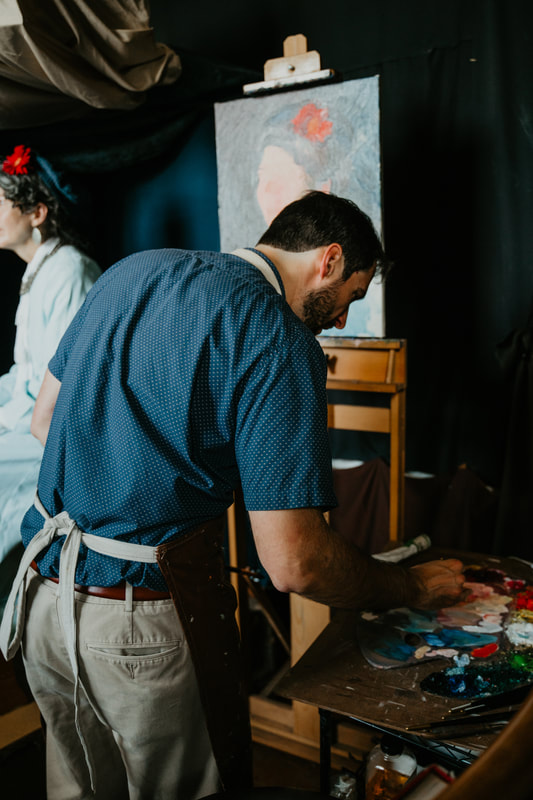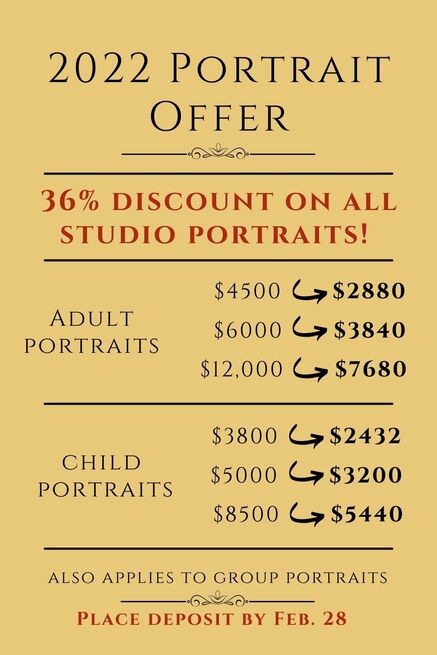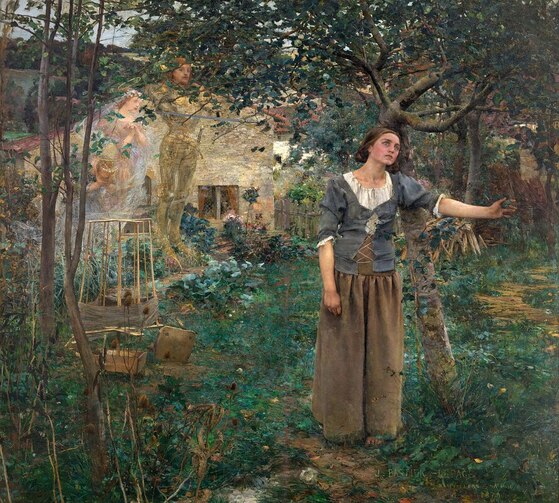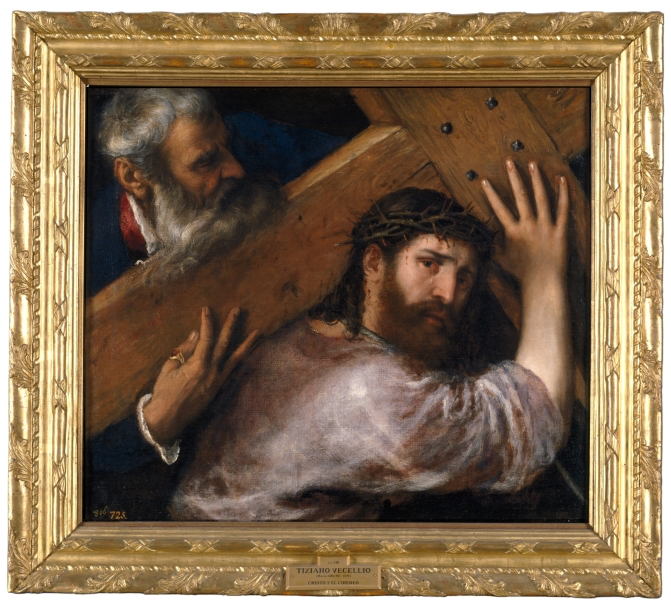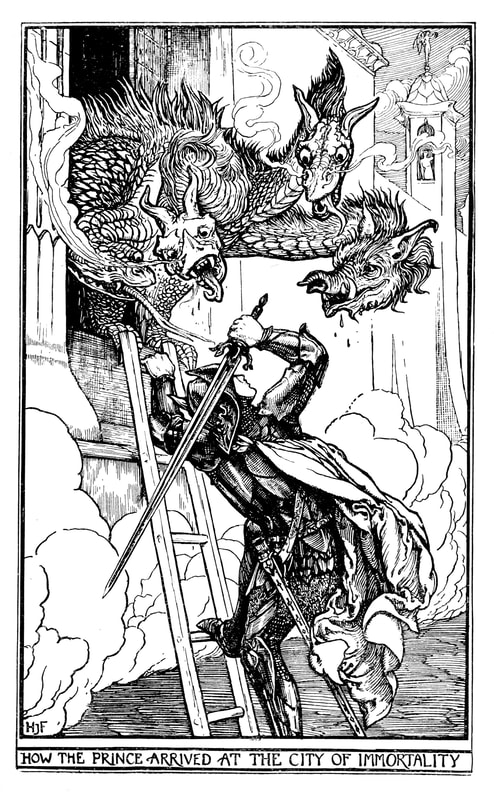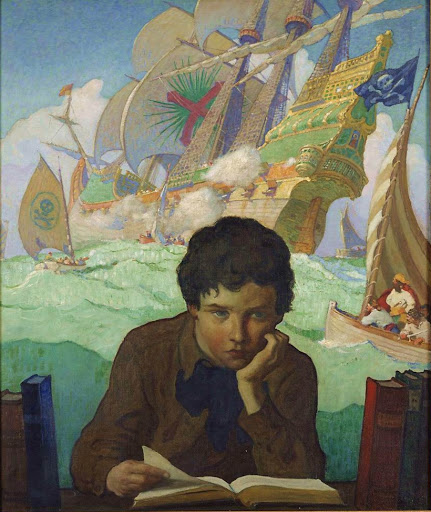|
Let's talk about how 2022 is the perfect year for you to have your/your loved one's portrait painted. (If the above video is not loading, it could be your browser.) It's a good time for celebrating the human person, particularly as discovered in the face. There's really no good way to abstract the face, because faces are essentially personal. Your face. Your loved one's face. A good portrait should give a sense of the whole person, but of course will focus on that all-important face. Our culture has been suffering from a defacing -- literally, a lack of faces. The effect has been chilling. Misunderstanding and fear are two of the major byproducts of this rejection of the essential goodness of the human face. But this is not how we were meant to live. We were made to relate to, to connect with, to love one another. So much of this hinges upon our ability to communicate with each other and understand one another, face to face. We're not just statistics, we're people. So, I say, let's get some portraits painted! Why have a portrait painted?Here are a few reasons why you might be looking for a painted portrait:
Why now?Here's the fun part. I'm offering a 36% discount off of any studio portrait booked by Feb 28. Why 36%? Because I just turned 36. (We wanted this announcement to go out on my birthday [Jan 11], but we've honestly just been too busy until now!) What does that look like, in terms of savings? See below: Can you tell I'm eager to dive in here? The Fine Print
Click here to see my portrait page for more on pricing and what the painting process looks like!Any questions? Feel free to comment below! Peace!
2 Comments
Not too long ago I was a guest on the show The Brothers F Bookcast with my friend Francisco and his brothers. They invited me to pick an art-related topic for discussion, so I went with a short story by the incisive Dorothy Sayers.
We had a fun time. You can have a listen here: https://www.thebrothersf.com/episode/dorothy-sayers-making-art-with-john-folley- Let me know what you think if you listen! Literature fans may want to add The Brothers F to their regular list! Your child is drawing all the time; your child has a gift for cartooning; your child is asking for more materials and opportunities... You're not an artist or have never taught art -- how to respond? Every so often I get these questions from parents of children who are obviously demonstrating early stages of artistic skill. What would I recommend they do for their child? What worked for me and what did my parents do to foster my love for and practice of the visual arts? Many people, not having received art training themselves or feeling ignorant regarding the arts, feel ill-equipped to foster their child's talent. I want to take away some of that fear and offer some encouragement So, without further ado -- my thoughts on the matter for those parents who have a child ~5-12 years old and want to know what I think would be best for them to foster their artistic growth as part of a loving family. I am going to focus on three areas that I think are helpful to think about for parents: lessons, gifts, and a culture of beauty in the home. Lessons - to do or not to do? First of all when parents think of fostering their child's artistic growth they think: lessons. The first piece of advice that I have about lessons for young kids is don't "Tiger-mom" it. Think of the mother or father who gets their 4-year old a violin and makes them practice for 2-4 hours a day. Yep. Don't do that. I know this is a pretty obvious exaggeration - most of us in our culture aren't tempted to take this extreme. But we are often tempted to over-program and over-nurture. We have a sense of parental guilt that I suspect is often driven into us for alternative motives (especially monetary, though others as well) that suggest to us that if we, as loving parents, don't give little Jimmy or Jill that extra lesson, that designer outfit, that extra gadget, trinket, or toy they will be forever stunted and it will be all our fault. Most likely something like the opposite is actually the case (see the Oscar acceptance speech by Roberto Benigni). Kids need freedom and time to explore the world, to think, and yes, to be bored! Necessity being the mother of invention, and boredom being a sure impetus to children to recognize the necessity of finding something interesting and exciting to do with their lives, boredom breeds creativity! So, long story short, don't give into the temptation to program your child's artistic interest to death! You are doing something very right if your child likes to draw - and may - for hours every day and has never been given a formal art lesson! That being said, if there is a week long summer class or weekend workshop on cartooning, calligraphy, or oil painting in which your child has expressed interest and which you have the financial means to facilitate, that could be a good and enriching experience as well. Such workshops were certainly enriching in my experience, but my parents never forced them on me. One thing that I think was very wise that they did was that they offered many of us 9 siblings the opportunity to go to the local community college for summer camp/day classes for 2 or 3 weeks in the summertimes when we were in grade school/middle school. We eagerly looked forward to these well-run and enriching classes in part because our parents gave us a large degree of freedom to select which courses we took - and guess what courses I chose? Speed reading, electricity/circuitry shop class, computer programming, acting, car repair, debate, and, oh yeah: calligraphy, cartooning, and oil painting. The way that my parents approached these classes was wise for three reasons: 1) It allowed us children to "buy in" to the classes ahead of time. We were more engaged because we were able to get excited about them and select the ones that appealed to us most. Often this meant those from which we would be most ready to learn. (if your child can earn his way towards such education himself, so much the better as his motivation will be all the stronger for having paid with his own hard-earned cash!) 2) We weren't forced into a narrow course of study or constricted based on what our parents thought were our particular talents or inclinations. Often my mother was surprised by our respective choices and she might advise for or against certain classes, but she generally allowed us to choose despite her own thoughts on the matter. And if it was a dud class, it was only a week or two long for an hour or two a day and we had others to look forward to as well! 3) It helped us to realize our limitations and start to narrow down our interests on our own. There were so many awesome courses to choose from, but we could only get in 3 or 4 per summer, so the decisions sometimes were hard to make, but they also helped us realize what we loved learning about! I can write another time about the kind of instruction that should happen when the child reaches a more mature age. At this stage, any lessons will be largely introducing the child to the materials of the medium; deeper-reaching critique and honing of skills will come later. My rule of thumb for this younger set is to respect the exploratory stage and not press the lessons. Supplies & Gifts The next thing I think parents often do and should be thinking about is the type of artistic tools that they give their children. Again, here it is important not to "over-nurture." Your son or daughter does not need the whole arts and crafts section from Hobby Lobby in their bedroom to be well looked after in this regard. Instead think one or two nice artistic gifts per birthday/Christmas (if you notice that your child has used the artistic gifts you gave them last Christmas/birthday or have asked for new artistic gifts). I think this is relatively easy when they are young: a nice set of colored pencils or markers/crayons and some simple coloring books (or sometimes even better: empty notebooks/sheets of scrap paper) is often a great place to start. A note on coloring books - try to get beautiful & tasteful ones - the Dover Coloring Book series is one that I have been particularly impressed with. Many varied and interesting subjects to choose from your young boys and girls that are generally drawn with good proportion and elegant lines. Bigger Kid As your son or daughter gets a bit older it may get to be a bit harder to think of what those next level artistic gifts for this age range could be. It could be as simple as upgrading their pencils and colored pencils to higher quality brands and materials. These twistable crayons will be more satisfying to the child whose fine motor skills are strong and for whom regular crayons are unsatisfactorily chunky for detailed drawing. Likewise, fine line Crayola markers are much more satisfying for the imaginative 5-8yo than the chunkier version that toddlers enjoy, but are still washable and not too pricey. I find Prismacolor pencils and colored pencils excellent and noticeably better than craft level pencils. Children should learn to treat their drawing pencils will care; dropping them or sharpening too roughly may damage the core of the pencil, resulting in an instrument that crumbles in fragments when sharpened. The next step up from coloring books in my experience was "Paint by Numbers" - I spent hours in delighted concentration as a young child working on mine! Young Adult Further gift suggestions for kids exploring different aspects of the artistic process: A wood-burning set (you could also browse options on Amazon) Dip pens & ink - carefully prepare and confine a work space with newspaper to avoid damaging ink spills! A Winsor & Newton basic watercolor set - watercolor is neater and less toxic than oil and acrylic options. You'll need watercolor paper - for beginners, an affordable option like this or what you might find at the craft store is fine! These watercolor brushes are excellent quality for a beginner and should be carefully cleaned, dried, and stored horizontally or upright after each painting session; more economical versions at the craft store will also do quite adequate for the beginner on a budget. A beginner's kit for pysanky Model airplane and paints Some whittling/woodcarving basics Some Sculpey (this can be bought in a colored set, but the plain white can also be painted with acrylic craft paint after baking) Many Christmases I recall immediately opening my gift, whether a dip pen, wood burner, or model airplane and spending hours immediately and over the coming months testing the limits of a new and exciting medium. I'm sure this enhanced my creative growth! Provide a good storage plan for these supplies and emphasize the artistic virtue of craftsmanship, tidiness and care with tools and the whole artistic process. Especially if your child has a future in an art studio, he should start learning now about how to keep organized and manage all these small (and sometimes precious) parts with care. The final step to every painting day in my studio is to wash my brushes and clean my palette for an efficient start on the next day! Orderliness promotes creativity whereas sloppiness detracts from mental clarity and studio practice. How to know when your child should be upgrading to higher-quality art supplies? One default approach is this: when he, as the the artist, can sense that the materials are holding him back from what he's envisioning accomplishing -- and when he has demonstrated that he can care properly for the lower-level art tools -- then it's time to move up a tier in quality and price. Home Culture of Beauty Finally and perhaps most importantly for your artistic child and your family as a whole I encourage you to have a culture of beauty in your home. This doesn't have to be a daunting task, but it does require a conscious decision and effort over time against the current of our largely utilitarian and often ugly culture. I encourage mothers and fathers to help make their homes a place where their children will encounter and be formed in beauty in two ways that I know my parents did for me. The first way is to have beautiful images hanging on the wall. If you are fortunate enough to be able to afford beautiful original artwork, I certainly encourage that (and of course I'm always available to help make that happen!). I also encourage framing beautiful prints of both sacred and secular subjects in your home. There is truly a wealth of beauty that our fore-fathers have passed on to us that all too often we don't experience - framed prints of these excellent paintings in the home is a true way to enrich your family. In my experience one of the works that has most shaped me growing up was the painting of St. Joan of Arc by Jean Bastien LePage. My mother had a print of it that was simply and elegantly framed. Over the years that print of that beautiful painting made a huge difference in my life. Over and over again I was drawn back to the loving craftsmanship of the artist who faithfully strove to capture the leaves, branches, twigs, facial expression, mood, mystery, and melancholy of the calling of Saint Joan of Arc, a simple peasant girl in a simple French landscape. The mystery and tension of the moment that LePage captured of the apparition of Saint Michael offering Saint Joan of Arc a sword and Saint Catherine and Saint Margaret with him -- one with her head in her own hands, a sign of her martyrdom and prefigurement of Joan's own martyrdom -- has mystified and amazed me for many years and has given me an understanding of what a great work of art should be and what it can do. Secondly, when parents give their children books with beautiful pictures, they often give a priceless gift to the child's imagination that lasts long after the books themselves have decayed. I encourage parents to have beautiful books of Western Art in their homes of great artists and architects like Bernini, Michaelangelo, Van Eyke, Peter Paul Reubens, Caravaggio, Valazquez, Rembrandt, Titian, Palladio, Edmund Tarbell, Boticelli, and Vermeer. In addition to these, beautiful story books are extremely important - from the color fairy books of Andrew Lang illustrated by Henry Justice Ford to their Saints and Heroes recently republished by Sophia Institute Press, to the treasures of visual storytelling of Arthur Rackham and N.C. Wyeth, Howard Pyle and many other amazing illustrators from the Golden Age (see The Golden Age of Children's Book Illustration by Richard Dalby for an introduction to some of these amazing men and women and I hope you are able to track down some of their amazing work!). Certainly some modern illustrators are well worth having in your collection as well (I suppose it would be a bit pert to recommend my own work in the Child's Christmas ABC Book and Mr. Mehan's Mildly Amusing Mythical Mammals among others, but alas, it seems I have done so already!). I think of Gennady Spirin, Tasha Tudor, Peter Spier, Jesse Wilcox Smith, Charles Santore, Scott Gustafson, David Weisner and many others when I think of excellent modern illustrators whose work is well worth having in your home. For other great children's books inspiration, I recommend the Instagram accounts Pease Porridge Press and The Good Books Last. Having such works will feed the imagination of your children with riches that will bear good fruit. I know that I encountered works in my home library that I copied for hours and learned a great deal from through admiration and enjoyment that have continued to form me as an artist and a man long after I have moved out of the house. Treat your child's imagination like the precious clean slate that it is, and - as you do your best to give your child only healthy and nourishing food - offer that little imagination only the best! I'll conclude with a quote from Arthur Rackham, one of true greats of illustration: "I can only say that I firmly believe in the greatest stimulating and educative power of imaginative, fantastic, and playful pictures and writings for children in their most impressionable years - a view that most unfortunately, I consider, has its opponents in these matter of fact days. Children will make no mistake in the way of confusing the imaginative and symbolic with the actual. Nor are they at all blind to decorative or arbitrarily designed treatment in art, any more than they are to poetic or rhythmic form in literature. And it must be insisted on that nothing less than the best that can be had, cost what it may (and it can hardly be cheap) is good enough for those early impressionable years when standards are formed for life. Any accepting, or even choosing, art or literature of a lower standard, as good enough for children, is a disastrous and costly mistake." I hope that helps, at least as a starting point and some inspiration! I look forward to seeing a new generation of artistic talent arise!
What other questions do you have? What other resources for beauty formation do you rely upon? Let me know, below! Really, both making a work of art and having a child are strikingly similar. Both involve great uncertainty at the outset. There are more potential parents frozen in fear at the uncertainty and responsibility of bringing new life into the world than there have been probably at any other extended time in history. Sadly, many don't overcome this fear. Artists or potential artists, when faced with the blank canvas and so much possibility, can also balk under similar pressure. This struck me recently when I assigned a project to my college level students. The task was to illustrate a poem from a series. The hardest hurdle seemed to be merely to put pencil to paper just to make the first sketch. Most who had the courage to do so were able to make the second and third refinements without much trouble. But for those who didn't the excuses were myriad: I can't draw; I don't have time; I can't draw people, hands, faces, animals, whatever; what should I choose from the poem - there is so much; what do you think I should do? (can you just make the decisions for me?). So many potential parents and potential artists trip on that starting line: commitment. To really start making something of a family and in art, you must say 'no' to a whole host of sparkling possibilities and say 'yes' to a host of potential problems and uncertainties. Maybe you'll have to work hard to figure out how to draw hands better because that is what your particular vision needs! Once parents are pregnant, the uncertainty continues: What will my child be like? Boy or girl? Saint or Sinner? What trade? The possibilities are vast even though you have the most important parameters figured out (mom and dad will be the foundation and support and guide through their lives). Likewise the artist who has set his hand to his craft never quite knows what will come out at the end! He can have some idea based on what his vision and skills are, but like with children, all art makes demands that are unforeseen and ultimately has a type of autonomy of its own. What could possibly overcome such uncertainties? Love. We need to be less afraid of making mistakes and more generous with bringing life. The artist is driven more by the love for the process and the product than he is stymied by the possibilities of error and failure. It is the same when having and raising kids. We need love, daring, and a little stupidity (luckily both of the latter are usually contained in the former!).
|
AuthorHello there, I'm John H. Folley, an oil painter in the Boston School tradition. Thanks for visiting the Beauty Advocacy Blog, where it's my job to help you become a more discerning art appreciator. Connect with John:
Categories
All
Archives
February 2024
|
